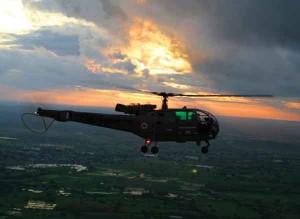The Gulf Wars
Operation Desert Storm, invasion of Iraq by the US-led coalition forces commenced on January 17, 1991 when eight Apache AH-64 attack helicopters supported by four Sikorsky MH-53 Pave Low III punched a hole in the Iraqi radar network through which fighters could fly with impunity.
During the ground war lasting 100 hours, 277 Apache AH-64 helicopters took part, destroyed over 500 tanks for the loss of a lone helicopter destroyed by a rocket propelled grenade. The US-led coalition in 2003 was not as fortunate. On March 24, 2003, the US 3rd Infantry Division launched a night attack on the Republican Guard Brigade deployed in depth to the West of Karbala. 31 Apache helicopters departed for the mission one of which crashed immediately after takeoff.
The mission was lured into a trap and one helicopter was shot down over target area. Of the remaining 29, all but one were seriously damaged by ground fire forcing a hasty retreat. After the mission, the squadron was left with just a single machine fit to undertake operations. The disaster put an end to the concept of committing sophisticated attack helicopters for deep strike in Iraq. Tactics in vogue were reviewed and changed thereafter. Subsequent reports attributed the disaster to compromised intelligence and stringent rules of engagement.
Helicopters will remain key weapon system in future wars. The success of helicopter operations will however hinge on the integration of the helicopter and fixed wing air campaign plans…
It was reported that Signal Intelligence picked up over 50 cell phone calls warning the Iraqi forces of the advancing helicopter armada. The attack helicopters were restrained from responding to ground fire from buildings to obviate the risk of collateral damage to civilian population. In intervening years since the first Gulf War, the environment for helicopter operations had changed immensely. However, attack helicopters are still being used by the International Security Assistance Forces in Afghanistan where they continue to sustain damage from ground fire.
The Helicopter in Future Conflicts
In all the wars from the US involvement in Vietnam in the fifties to the invasion of Iraq in 2003 and the ongoing operations by the ISAF in Afghanistan, helicopters have played a major role. However, their effectiveness has has often been eroded by the lethality of the enemy air defence system. The phenomenal success of helicopter operations in Vietnam is eclipsed by the current assessment of the vulnerability of helicopters to ground fire particularly in mountainous terrain, in desert areas and in urban warfare.
The success in Vietnam can be attributed to an extent to the limitations of the North Vietnam arsenal, immunity from ground fire while flying above dense forests and the overwhelming numbers committed by the US. The helicopters of that era were comparatively easy to repair and maintain in the combat zone, whereas modern helicopters are highly sophisticated, carry space age technology and need elaborate maintenance support. Unit cost of helicopters have also escalated exponentially thus reducing substantially the numbers available for deployment.
Future wars are likely to witness helicopters being employed extensively in the combat zone but whether they will be used for offensive missions or in supporting roles will depend on the environment in which they are deployed. The Indian Army doctrine envisages a two-front war i.e. simultaneous conflict against China and Pakistan. In addition the Indian Armed Forces perceive for itself tasks such as strategic operations transcending national boundaries, asymmetric operations and sub-conventional threats which could include counter insurgency. However, lessons from the wars of the past and ongoing conflicts around the world indicate that there could be serious constraints on the use of gunships and attack helicopters in the high altitude regions of the Himalayas.
The air defence environment in the desert areas across India’s Western borders, is well equipped to deal with low speed flying machines such as helicopters. Combat operations by helicopters therefore would have to be in synergy with combat missions by the fixed wing aircraft of the IAF. Helicopter operations therefore would have to be dovetailed into the air campaign from the initial planning stage itself. Fratricide in close combat has to be avoided at all cost and helicopters have to train to fight in coordination with fighter aircraft and aerial drones.
The Eastern front against China is a different environment. The access routes into India are well defined and do not lend themselves to manoeuvre warfare by the enemy. The terrain poses serious problems to fixed wing aircraft in providing support to own ground forces and helicopters will be ideally suited to provide combat, logistic and communication support. In the India-Pakistan or India-China context the use of fixed wing fighters in a conflict situation would be seen as escalatory inclined to push the adversary to the next level of conflict; but the use of combat helicopters may not have the same effect. Any Indian expeditionary force operating “out of theatre” would need helicopter support for a number of roles as own combat air support is unlikely to be available. Experience also shows that helicopters will be an essential part of any force earmarked for sub-conventional threats and counter-insurgency operations.
If the helicopter is to be an effective combat platform in future wars, and evolve new techniques to counter current and future threats need to be evolved based on lessons from previous wars.
Modern helicopters have a variety of systems, weapons, mission capability and on-board technology. However, experience in conflicts in the recent past indicates that despite protective measures, helicopters are vulnerable to ground fire. If the helicopter is to be an effective combat platform in future wars, and evolve new techniques to counter current and future threats need to be evolved based on lessons from previous wars. Depending purely on emerging technologies to throw up solutions will be counter productive as the success of helicopter missions will be influenced by the operating environment. Helicopters will remain key weapon system in future wars. The success of helicopter operations will however hinge on the integration of the helicopter and fixed wing air campaign plans, supported by the capability of the operating crew to innovate tactics, and the competence of the staff to mix and match the capability of the helicopter fleet to the threats at hand.
A balanced air force must have the capability to fight across the full spectrum of conflict and helicopters are an essential part of that force and their use in combat is only limited by one’s imagination. The modern military helicopter is equipped with state-of-the-art electronics for acquiring targets, identification and their destruction by day or night. It has armour protection for the crew and vital components of the machine, electronic warfare suites for offensive and defensive counter-measures, damage resistant engines and a host of other combat enhancement systems which the manufacturers claim, make it invincible on the battle field. Unfortunately, like the Biblical story, ill-equipped Davids of the world with low grade technology weapons bring down these Goliaths from time to time, and that is the dilemma that faces military planners.






